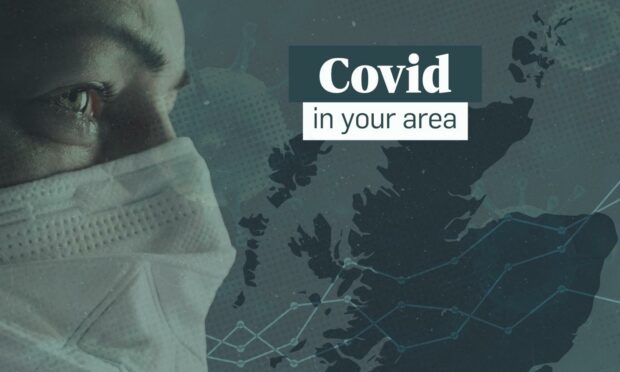As the cap on large scale outdoor events is to be lifted from Monday, after restrictions were put in place in December to deal with rising Covid-19 case rates, we look at the current situation in neighbourhoods across the area.
Since Boxing Day, there has been additional restrictions on large outdoor events, only allowing 500 people to attend.
Other protective measures on indoor live events are still in place, but it is hoped that they may be lifted from January 24.
From today, January 13, the Scottish Government will also begin reporting on the number of people with Covid-19, confirmed by either a first lateral flow test, or a PCR test.
Earlier this month, the government announced that people who have no symptoms but test positive via a lateral flow test will not have to get a follow up PCR.
Our interactive maps below show the case rate by intermediate zone for Aberdeen, Aberdeenshire, Highland and Moray. The islands have not been included as case numbers tend to be very low and are often suppressed as a result.
Each intermediate zone (IZ), represents an area, quite often a neighbourhood, within each local authority.
Hovering over each area will give additional information including the population of each neighbourhood, how many positive cases have been recorded there in the past seven days, and the seven-day case rate per 100,000 population – a measure which is used to compare areas with different populations against each other to accurately track the spread of the virus.
Below includes details for case rates accurate as of January 10, which was the latest information at the time of writing, as this data is subject to a three-day lag in being uploaded by Public Health Scotland.
We have compared case rates to previous weeks to provide context about whether cases are rising or falling in your area.
What are case rates like in Aberdeen?
The below chart shows the case rates for each neighbourhood in Aberdeen.
In Aberdeen, the neighbourhoods with the highest case rates were Bucksburn South, Kincorth, Leggat and Nigg South and Cummings Park.
Bucksburn South had a case rate of 1,899.01 per 100,000 population, with a total of 88 positive cases in the previous seven-day period, out of a population of 4,634.
Kincorth, Leggart and Nigg South had a case rate per 100,000 population of 1,727.12, and 90 Covid-19 cases out of 5,211 people. This was followed by Cummings Park, which had a slightly lower case rate of 1705.38 per 100,000 population, and 58 positive cases in the week out of 3,401 people.
However, most case rates have decreased this week compared to last week.
Last week, the top three neighbourhoods were Denmore, Bucksburn South and Kingswells.
What are case rates like in Aberdeenshire?
The below chart shows the case rates for each neighbourhood in Aberdeenshire.
Case rates have decreased in most areas of Aberdeenshire compared to last week.
The three areas with the highest case rates this week were Huntly, Stonehaven South and Mearns and Laurencekirk.
Huntly had a case rate of 1,506.32 per 100,000 people, and 62 positive Covid-19 cases in a population of 4,116.
Meanwhile, Stonehaven South had 75 positive cases and a case rate of 1,459.43 per 100,000 people, where 5,139 people live in the area. Mearns and Laurencekirk saw a case rate of 1,431.45 per 100,000 people and 64 cases out of 4,471 people.
Last week, the top three neighbourhoods were Blackburn, Fetteresso, Netherley and Catter and Newtonhill.
What are case rates like in Moray?
The below chart shows the case rates for each neighbourhood in Moray.
This week, the neighbourhoods with the highest case rates were Buckie West and Mains of Buckie, Elgin Cathedral to Ashgrove and Pinefield and Elgin Bishopmill East and Ladyhill.
Buckie West and Mains of Buckie had a case rate of more than 2,000, although it has dropped compared to last week and now has a case rate of 2,103.13 per 100,o00 population and 104 positive cases in a population of 4,945.
Elgin Cathedral to Ashgrove and Pinefield recorded a case rate of 1,731.19 per 100,000 population, and 72 cases in the past seven days out of 4,159 residents. Meanwhile, Elgin Bishopmill East and Ladyhill had a rate of 1,573.1 per 100,000 population and 51 cases in the last week out of 3,242 people.
Every neighbourhood in Moray saw a decrease in Covid-19 case rates.
Last week, the top three neighbourhoods were New Elgin West, Elgin Bishopmill East and Ladyhill and Burghead, Roseisle and Laich.
What are case rates like in the Highlands?
The below chart shows the case rates for each neighbourhood in the Highlands.
The neighbourhoods with the highest case rates this week were Inverness Drakies, Inverness Slackbuie and Lochalsh.
Inverness Drakies had a case rate of 1,726.43 per 100,000 population and 39 positive cases in the past seven days out of 2,259 residents.
Inverness Slackbuie had a case rate of 1,651.33 per 100,000 population and 61 cases out of 3,694 people, while Lochalsh had a case rate of 1,489.12 per 100,000 population and 39 positive cases out of 2,619 people.
Case rates decreased in almost every area of the Highlands compared to the week before.
Last week, the top three neighbourhoods were Inverness Slackbuie, Inverness Westhill and Inverness Smithton.
Comparing the north and north-east
The below chart shows the seven day case rate in each local authority, including the islands, since March 2020.
How does the north and north-east compare to the rest of Scotland?
The below chart shows the top 10 neighbourhoods in Scotland with the highest case rate per 100,000 population.
No neighbourhoods in the north and north-east were in the top 10 highest neighbourhoods in Scotland this week.
